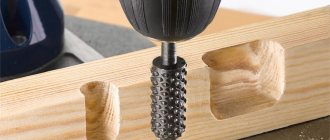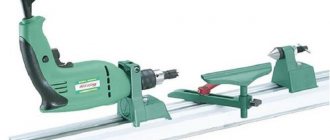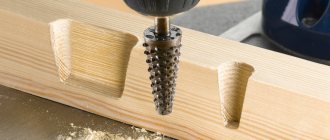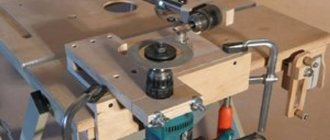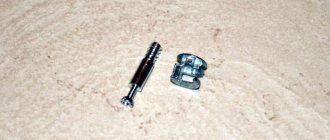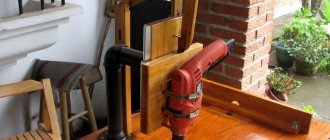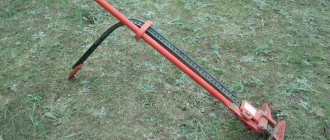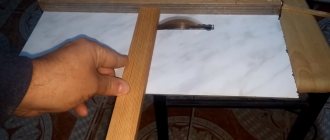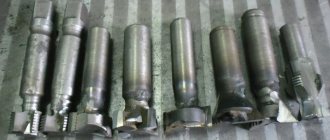The functionality of electrical appliances can be increased by connecting devices and various additional accessories. Thus, a wood cutter for a drill allows you to work with wood and cut shaped notches in timber. They achieve a high-quality level in roughing or finishing of blades by installing working attachments with an actuator.
Wood cutter for drill
Manufacturers have produced various types of cutting elements, but they need to be selected correctly; they must be suitable for working with a specific drill.
general information
The drill cutter is one of the replaceable elements. Each part in the assembly performs an important function. The motor of the electrical appliance transmits the rotation speed to the shaft, and the nozzle with accessories will rotate with it.
Milling cutter
Only the cutter processes a given area. The final result depends on the correct choice of which, combination of parameters, compliance with conditions.
Wood cutter for a manual router - what is it and what is its purpose
A cutter for a manual electric router is a small-sized cutting tool. Consists of three simple parts:
- shank;
- supporting body;
- cutting knives fixed in the supporting body.
A lot depends on the quality of the cutter. As experienced craftsmen say, it is not so important what kind of router is used, what matters is the quality of the cutter.
However, it is better to work with a high-quality, convenient router. During operation, the cutter rotates at enormous speeds, due to which cleanliness, speed and quality of processing are achieved. The electric motor of the milling cutter, through an overdrive gearbox, gives the cutter a rotation speed from 10,000 to 30,000 rpm. The more revolutions the router can produce, the better.
How the cutting part works
Actuating mechanism
The actuator consists of 2 elements:
- shank (1) – it is clamped by a cartridge to transmit torque;
- working sphere (2) – there are sharpened blades on the sides of the head.
The configuration of the cutting edge provides different capabilities to this knife. The quality and type of sharpening are used to perform tasks of varying complexity. An additional element - a support bearing (3) - can simplify milling with a drill or expand these functions. For example, process a workpiece according to a template. If the system is dismountable, the cutter with its constituent parts regulate the work processes in the desired direction using:
- locking couplings;
- calibration bushings;
- washers;
- screws
The shank or base of the cutter comes in different lengths and diameters. These parameters are taken into account when choosing.
The chuck must hold the part tenaciously and be long enough to perform specific operations. The technical characteristics and purpose of the blade determine how much work can be done with it. It is sharpened manually and using high-precision equipment if there are no backlashes in the structural elements. In addition to sharpening, the alloy from which the item is made is also important. The hardness level of the steel must correspond to the structure being processed, in this case wood.
The standard set of cutters includes elements of different parameters and categories in the form:
- mounted, when the landing part with a diameter of 32 mm can only be installed in stationary milling equipment;
- end with a shank from 8 to 12 mm. in diameter, they are mounted on the machine shaft and on the drill.
This assembly replaces a professional milling cutter when processing:
- natural wood;
- plywood;
- chipboard;
- MDF.
When the cutting tool is going to process plywood, a knife with a high level of wear resistance is inserted. Let's say that a jigsaw with its cutting plates contains a strong alloy and is not sharpened.
Popular manufacturers
Milling cutter manufacturers today can be divided into two groups:
- milling cutter manufacturers who produce accessories for their power tools and compatible tools from other manufacturers;
- manufacturers of cutting equipment who specialize in this and do not produce power tools themselves.
The former produce products of fairly good quality, since they are interested in ensuring that their instrument works successfully. But they are not interested in their equipment working forever so that sales are not one-time. From time to time, such cutters are replaced with new ones.
The most widespread and popular manufacturers are Encore, Bosch, Fit, Corvette and others.
The latter try to maintain a reputation for the quality of their products and produce professional products with a long service life. However, among them there may be “nameless” products of poor quality of unknown origin.
What do they pay attention to?
If you use a drill for milling wood, take into account a number of features:
- The operation of bearings on a shaft with the calculation of axial longitudinal load. In some types of mechanisms, a lateral force is applied, which affects the rapid wear of parts.
- Speed of revolutions.
- Cooling methods.
- Engine power.
- Handle placement.
- Cartridge quality.
Electric drill cutters
The electrical device must be equipped with a function that regulates speed with a large reserve of power - this means that cutters for an electric drill can be installed on it.
If there is incompatibility in the mechanism of devices, negative consequences are possible:
- the tool will overheat;
- the gearbox will fail;
- in the process, a distortion of the workpiece is formed;
- the shank will pop out due to an unreliable cartridge.
There are unwritten rules for milling:
- actions are performed slowly, accurately and accurately;
- check all connections, electrical wiring, fixation;
- Allow the drill to cool periodically.
When large volumes of work are to be done, a carbide nozzle is needed. Only after the equipment is securely fixed in the chuck do they begin to mill.
Choose a knife according to the following criteria:
- size - the parameter affects the assigned technological task;
- shape, configuration, location of the blades;
- sharpening angle;
- manufacturing materials - the performance of various operations and service life depend on the steel;
- purpose - if the milling drill is durable, it is used not only for wood drilling, but also for harder materials.
When buying any product, they visually evaluate it and look at the manufacturer’s company. The reputation of the enterprise will reveal the pros and cons of production. You need to do the same with the equipment. If the buyer is not rich enough to afford a cheap thing, the cutter should be of good quality and expensive.
QUESTIONS - ANSWERS
After the publication of this article, we received many questions about cutters and this resulted in the following Questions - Answers section:
Milling cutter ball
Which cuticle ball cutter should I choose?
Answer:
The ball cutter cutter is the most difficult for beginners to master. Teachers recommend first mastering a combined manicure, where the skin is cut with scissors or tongs, and only then cleaned with a ball. After mastering this technique, you can move on to completely removing the cuticle using only a round nozzle.
To choose, you need to decide on the material, diameter and hardness (blue, red or yellow notches).
Material: to remove the cuticle, it is best to use a diamond cutter; for further polishing, a corundum cutter.
The ball cutter comes in different diameters: from 1 to 6 mm. The size is selected based on the task and area of the area being treated. Optimally – 2-3 mm.
To remove the skin around the nail, it is better to use a diamond nozzle of medium or soft abrasiveness with a blue or red notch.
The ball cannot be used at high speed, otherwise the master will not be able to control it. Optimal - 5,000 - 10,000 rpm.
Frequency of cutter replacement
How often do you need to change manicure cutters?
Answer:
Reusable metal and diamond cutters are recommended to be changed every 4-6 months, depending on the density of customer traffic. Ceramic cutters wear out faster. For them, the service life is 1-3 months. Disposable caps are discarded after each use.
Corundum tips with a blunt end can be filed with a regular file for natural nails to return them to shape.
Why do manicure cutters get clogged?
Answer:
Each nozzle has its own purpose. To remove gel polish or artificial nails, it is better to use ceramic corn tips or a rounded cylinder with a blue notch. Metal or diamond cutters will clog when working with artificial material in a matter of minutes.
You should also not use cutters on wet nails and skin; they become clogged very quickly and it is impossible to clean them right away; it is necessary to go through the full stage of disinfection and sterilization. If the cutter is clogged, it is better to replace it with a new one, as intended, and continue working.
Sterilization
Do new manicure cutters need to be sterilized?
Answer:
All reusable cutters must be sterilized before each use on a client, including new ones. First, they are placed in a disinfectant solution, then washed under running water, laid out to dry in the open air, and then sent to a dry-heat oven in craft bags or on special trays.
Lifting the cuticle
Which cutter should I use to lift the cuticle?
Answer:
Lifting the cuticle is the first stage of processing, for which a cutter with a blunt or slightly rounded end is suitable. Professional craftsmen recommend using a cylinder, cone or truncated cone.
What to choose, a truncated cone or a flame to lift the cuticle?
Answer:
At the first stage, raising the cuticle, professional craftsmen recommend working with a truncated cone. And after that, connect the flame or lentil cutter at the second stage, opening.
Cuticle opening
Which cutter should I use to open the cuticle?
Answer:
You can open the cuticle and remove the pterygium using a fissure diamond attachment with a rounded end, a bullet, flame, or lentil attachment. It is important to hold the cutter at a slight angle so that its convex part does not touch the nail. The fissure should run parallel to the plate.
Cuticle removal
Which cutter should I use to remove cuticles?
Answer:
The optimal solution at this stage is a ball attachment. The peculiarity of working with a cutter is that it must first go under the open cuticle and, by applying pressure, come up, cutting off the skin. All movements of the ball come from the inside of the cuticle outward. Do not rub the nozzle in one place for a long time, so as not to injure or cause a burning sensation.
After using the diamond ball, you can polish the cuticle and rollers with a corundum ball.
To work on the cuticle in front of the ball, you need to lift and open it with a corundum cone, clean the pterygium with a fissure or flame, and only then remove the skin with a round cutter of the required size. The ball is also convenient for cleaning the side rollers.
You can also remove the cuticle with a diamond cylinder with a rounded end (red notch).
Design Features
The cutting device is based on the teeth around its body and the manufacturing technology of the structure itself:
- solid - made of one metal composition;
- combined - with knives made of one hard alloy and a body made of another metal;
- welded, when the shank is connected to the blades by welding;
- soldered - the assembly is fixed by soldering.
The blades can be pointed with a front and back flat surface. The disadvantage of such items is that they are sharpened; they shrink in size, so they are not suitable for reusable use. Unlike backed bits, which can be resharpened. On the front side they are flat, and on the back they are twisted like an Archimedean spiral. Such a profile is obtained by uniform movements - translational and rotational. The backing procedure is performed with cams, which creates a stable back angle along the entire length. A similar design is created for cutters:
- shaped;
- worm;
- modular.
Cylindrical peeling knife
The mounted cylindrical peeling knife has separation grooves for chips.
They are directed in one direction, and the backed tooth is directed in the opposite direction. Blades placed in different directions allow high-quality processing of side walls. They are pressed into the body, where the radial corrugations move. After sharpening, the dimensions of the actuator do not change.
Functionality
Initially, cutters were used in dentistry and were intended for dental treatment. Only the forms in demand for nail treatment came into the nail industry.
Of the huge number of cutters on the market, each can be used at one or another stage of a manicure or pedicure. But a number of attachments are distinguished by increased functionality and can be used at several stages. Some of them can complete the entire manicure procedure in the hands of a skilled manicurist. Let's look at the most functional cutters for removing coatings and working with skin and nail plates.
Coating cutters
Any attachments with teeth that have indentations between them will do. For gel polish, fine teeth are no more than 1 mm, and for acrylic and gel, deep teeth. This is necessary in order not to saw through areas with an increased risk of sawing, for example, the cuticle, lateral sinuses. Fine teeth leave behind a smooth surface. It is worth focusing not on the speed of material removal, which is provided by deep teeth, but on the safety of removal.
If we take cutters with large threads larger than 1 mm, then even with high-quality material removal, grooves will remain. Next, they will need to be additionally polished with buffs and files, which will require additional time from the master.
The teeth have a direction - clockwise or counterclockwise. There are also reversible teeth, “looking” in both directions at the same time. They are suitable for left-handers and right-handers.
The cone-shaped nozzle is the best for removing material from nails. It provides the largest contact area and the highest processing efficiency.
Based on the material of manufacture, it is worth considering the following cutters for removal:
- Carbide cutters are similar to metal cutters, but they wear out quickly. They are enough for 40-50 material removals. The cost of each varies from 100 to 600 rubles from top manufacturers.
- Steel cutters are more durable and wear-resistant. They differ from carbide ones only in the shade of the metal. Their cost starts from 500-600 rubles.
- Ceramic cutters are the most durable and durable. They last for 2-3 years.
There are metal cutters with spraying. This can be plating with galvanic gold or titanium. A distinctive feature of these attachments is the ability to monitor wear. When the coating wears off, it’s time to change the cutter.
Titanium-coated cutters for material removal have a blue iridescent surface. This coating is stronger than electroplating gold. The nozzles are highly wear resistant.
Step-by-step analysis of hardware manicure
Cutters for working with skin and nail plates
The first category is diamond cutters. They are suitable for manicures, cleaning sinuses, side rollers and cuticle areas.
Different abrasives are designed for different functions.
Diamond cutter categories:
- galvanic;
- sintered monolithic.
Galvanic cutters feature a galvanic base, a metal onto which an adhesive layer is applied and an abrasive is sprayed. This results in a grainy surface. Depending on how these coatings are sunk into the adhesive base, the nozzle will either process well, or quickly become clogged and worn out during operation.
It is best when the spraying is half recessed into the adhesive base. Diamond galvanic cutters last from 5 to 40 manicures, depending on whether they are used to process the coating or just the skin. Economical in cost - from 50 to 650 rubles, depending on the manufacturer and the quality of spraying. They are enough for 1-4 weeks of work with a dense flow of clients.
The marking of galvanic attachments starts from the white notch.
- White notch is rare and practically useless in the daily work of a craftsman. The nozzle is more suitable for polishing.
- Yellow diamond cutter - for working out, polishing the skin, removing remnants of pterygium in sensitive skin.
- Red abrasive is a universal tool for all stages of manicure. The most common use is internal cleaning of pterygium in the lateral sinuses and from the surface of the nail plate.
- Blue abrasive - only for external areas of the skin - cutting the cuticle and processing the side rollers. Not on sensitive thin skin.
- Green abrasive - coarse - is rarely used in manicure. More often - in pedicure for treating calluses and rough skin of the side ridges.
- The black diamond cutter is the roughest and most aggressive. Not for manicure. Can only be used to remove small areas of gel polish in hard-to-reach areas.
The second category is monolithic or sintered diamond cutters. Serve from 2 to 10 years. Expensive, the price can reach 8,000 rubles.
- Sintered is an attachment in which particles of real diamond are applied to a workpiece and baked in a furnace, turning into a solid tool. It lasts much longer than conventional spraying - up to 3 years.
- Monolithic - differs in that diamond particles are placed on a very thin pecking base, in several rows, and then baked. In this option, there is less choice of shapes, since the technology does not allow making a thin, sharp tip. It's always more rounded.
Basic actions and their order
Wood is a soft raw material. Different types of cutting tools have been developed for its processing. When choosing equipment you need to consider:
- The wood cutting knife should not be used for grinding or cutting metal structures.
- The drill for metals is made of strong high-alloy compounds that cannot negatively affect the operation with chipboard. There will be no overheating of the motor and gearbox. The end blade has this design; it is used to cut sheet material, and small-sized groove milling is performed. Although such models are endowed with a small number of feathers.
Groove cutter with different geometries, convenient for creating long grooves. And shaped cutters are used only for tortuous, complex design configurations.
Edge knife
The edge knife itself speaks about its purpose; it is good for sanding the sides. A bearing is installed at the end of such blades; it regulates the direction and prevents it from moving away from the formation of the edge. Finishing is performed on both straight and shaped edges.
Repairs to wooden buildings are not complete without sealing old holes and cutting out new ones.
Actuator of different designs
This requires a drill, and to perform several tasks you will need a whole set.
Where each tool has its own dimensions in diameter and length. They have the peculiarity of changing proportionally. When one value increases or decreases, another indicator changes in the same direction. There are no thin and long elements; they will simply break under a slight load. For example, at 12 mm. diameter, the length will be a drill bit for a drill of 50 mm., There are also 60 mm. These devices are also different in appearance:
- spiral;
- screw;
- feathers;
- ring;
- countersinks;
- flexible.
Through space can be created, different in geometric shape:
- cylindrical;
- conical;
- stepped;
- square.
The mechanism for wood processing, unlike metal processing, has a conical end; it is used to mark the drilling location.
Carbide burrs
Carbide burrs are cutting tools used for removing welds, removing burrs, leveling surfaces, and finishing work on products made of plastic, wood and stone.
- Sort:
- Price
- Popularity
- View:
- Tabular
- Lowercase
Used on straight grinders with electric drive or pneumatic drive for processing the outer surfaces of profile parts (cutting edges, deburring and chamfering).
Used on straight grinders with electric drive or pneumatic drive for processing protruding parts of non-flat parts - grinding, processing joints, removing welded reinforcements.
Used on straight grinders with electric drive or pneumatic drive for processing surfaces inside complex profiles (processing radius grooves, forming internal radius mates).
Used on electric or pneumatic driven straight grinders to finish surfaces in narrow or hard to reach areas.
Used on straight grinders with an electric drive or a pneumatic drive for processing the internal surface of the “corner” type (cutting edges, removing burrs and chamfers, processing radius grooves, forming internal radius mates).
Used on straight grinders with electric drive or pneumatic drive for processing joints of cylindrical parts - grinding, processing joints, removing welded reinforcements.
Used on straight grinders with electric drive or pneumatic drive for processing the outer surfaces of profile parts (cutting edges, deburring and chamfering).
Used on straight grinders with electric drive or pneumatic drive for processing parabolic surfaces inside the profile - grinding, processing joints, removing welded reinforcements.
Used on straight grinders with an electric drive or a pneumatic drive for processing the internal surface of the “corner” type (cutting edges, removing burrs and chamfers, processing radius grooves, forming internal radius mates).
Used on straight grinders with electric drive or pneumatic drive for processing joints of cylindrical parts - grinding, processing joints, removing welded reinforcements.
Used on straight grinders with electric drive or pneumatic drive for processing remote (recessed) places in profile parts (cutting edges, deburring and chamfering, processing grooves).
Used on straight grinders with electric drive or pneumatic drive for countersinking and edge processing of cylindrical surfaces.
How to prepare a drill for milling
Electric drill
It may not be possible to open a full-fledged carpentry business with an electric drill, but in a home workshop, various milling procedures are often simply necessary.
Reconstruction begins from the place where the electric motor will be mounted.
If you don’t have an old table, you can put it together from available materials - boards, plywood. Bars are suitable for support legs. A recess is made on the countertop for installing the device with guides. You will need to cut a semicircular groove with a saw and drill through the circles to attach the support sheet.
After building the table you will need:
- electrical appliance;
- small cutter for testing;
- cartridge;
- chipboard sheets.
The drill is secured with clamps to a chipboard stand. The cutter is installed on the shaft. The elevator will be the carriage of the power tool with the main body. The stand and the limiting platform are connected at a right angle. The knife should extend beyond the base.
Recommendations
- You cannot combine an inch collet with a millimeter shank, otherwise the tool will quickly break.
- It is necessary to ensure full contact of the equipment with the surface being processed.
- For better sliding of the head, use special lubricants.
- You cannot put too much pressure on the burr head, because it will overheat and work slower.
- Do not touch the tool shank to the surface of the part.
- It is important to maintain a high rotation speed to avoid unevenness.
Edge sharpening
The set of equipment is not thrown away after long use; if corrected, they retain their normal condition. This is how a shaped end mill is sharpened along the front cutting edge with a diamond stone. It is attached to the table and the blade is moved along it. The sharpener is moistened with soapy water. The pointed areas will gradually recover with minimal loss in diameter.
If there is a guide bearing, remove it first, then start sharpening. Before work, first clean the cutter with a solvent to remove any remaining wood resins. The sharpening stone is chosen of the correct shape according to the level of grain. It depends on the thickness of the layer being removed and the degree of surface grinding.
They sharpen each tooth in turn, maintaining symmetry with the same number of movements, pressures - in the same direction. For soft cutters, use ordinary sandpaper, abrasive paper, which is glued to a steel or wooden strip.
Grinder
If you have a sharpening machine, then manual work can be replaced with mechanical work. The tip is restored to its former state all around, material is used for it:
- white or normal electrocorundum;
- elbor;
- green silicon carbide.
The machine can sharpen even the most complex spiral tooth shapes using rotational and translational movements. The cutter, during its longitudinal movement towards the circle, makes synchronized turns along the axis. The position of the edge does not change in height, and contact with the abrasive is maintained along with the sharpening angle.
At the end of the procedure, a control inspection of the blade is made for chips and cracks. A special device is used to determine the deformation for runout and the absence of changes in the angles. A deviation of 1 degree is allowed. Good care and correct editing will extend the life of cutters and main power tools.
Summary
Article Name
Wood cutter
Description
Wood cutter for drill 35 mm, 50 mm, 100 mm. Wood end mill for drill. Do-it-yourself wood cutter from a drill.
Author
Sarychev Alexander Viktorovich - forensic construction and technical expert, candidate of technical sciences
Publisher Name
Wikipedia of construction tools
Publisher Logo
- Related Posts
- Do-it-yourself drilling machine from a drill - detailed instructions, drawings
- DIY stand for drill - detailed instructions, drawings
- Drill attachments for car polishing
« Previous entry
Safety cutters
The conditions for safe use of a cutter are compliance with the basic rules of work.
Such criteria include:
- incline;
- pressure intensity;
- position angle;
- aggressiveness of the instrument.
99% of attachments will be dangerous if mishandled.
The first category of safe cutters is Silicone Carbide Grinders. They consist of a mixture of silicone with carbide chips, giving it the desired shape for manipulation in manicure. They are convenient for cleaning ridges and pterygium from the nail plate.
Silicone carbide grinders come in different shades, which are responsible for marking the abrasive. Possible colors are green, gray, brown.
- The softest ones are green. Only polish the skin: fine grinding and polishing of the nail plate.
- Gray is a more functional sander. Removes small burrs and dry areas.
- Brown is the most functional, as it polishes both the cut and the skin, and removes pterygium from the nail plate. It is the brown silicone carbide grinder that can be called a safe attachment. It has a soft and elastic surface with small abrasive inclusions, which removes only soft tissues, and cannot damage the nail or strong skin.
The second category of safe ones is Corundum stones . Used to polish the skin and clean off the pterygium. They are considered safe, but do not forget that this is a stone. Its difference is that the surface does not consist of bulges, but of small pores and depressions that capture and clean the skin. If the pressure and position in relation to the work surface are incorrect, it is still capable of making cuts.
Safe cutter “Oney Clean” - without abrasive, with blades. It can be used to remove pterygium from the nail plate without scratching it, and also lift the stuck cuticle. Like any rotary tool, it requires careful operation. If you grip incorrectly and apply intense pressure, you can make cuts with it.
Burrs
- Burrs type A - cylindrical with smooth end
- Burrs type B - cylindrical with sharpened end
- Type C burrs - cylindrical with ball end
- Burrs type D - spherical
- Burrs type E - oval
- Burrs type F - parabolas with rounded head
- Burrs type G - parabolas with a pointed head
- Burrs type H - flame tongue
- Burrs type J - 60 degree conical
- Burrs type K - 90 degree conical
- Burrs type L - spherical conical
- Burrs type M - conical
- Burrs type N - reverse conical
- Bohre metal core drills
- Core drills for metal Karnasch
- Core drills for metal Rotabroach (England)
- Gasoline impact wrench VESSEL GT-3500GE and accessories
- Spare parts for petrol impact wrench VESSEL GT-3500GE
- Rail core drills
- Rail drilling machines BDS-machines
- Geismar rail drilling machines
- Rotabroach rail drilling machines
- Rail drilling machines Vector
- Rail drilling machines Hi-tech tool
Popular collections
Sorting
- default
- by popularity
- by price
- by name
- Back
- 1
- 2
- 3
- 4
- 5
- 6
- Forward
